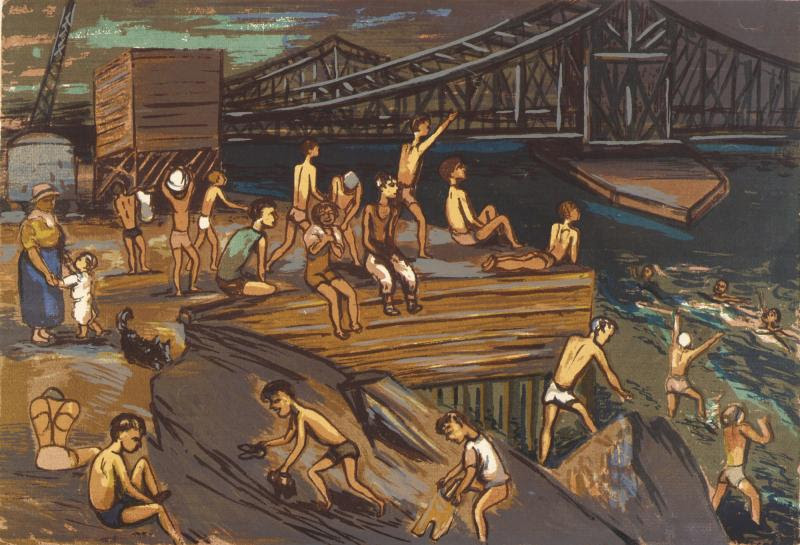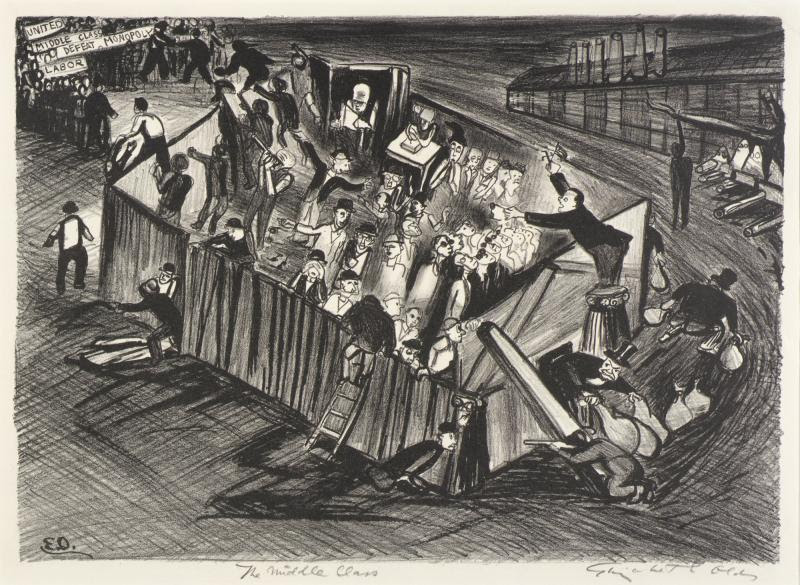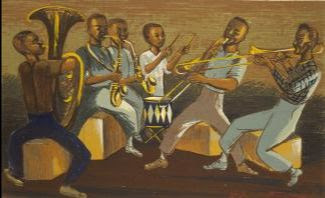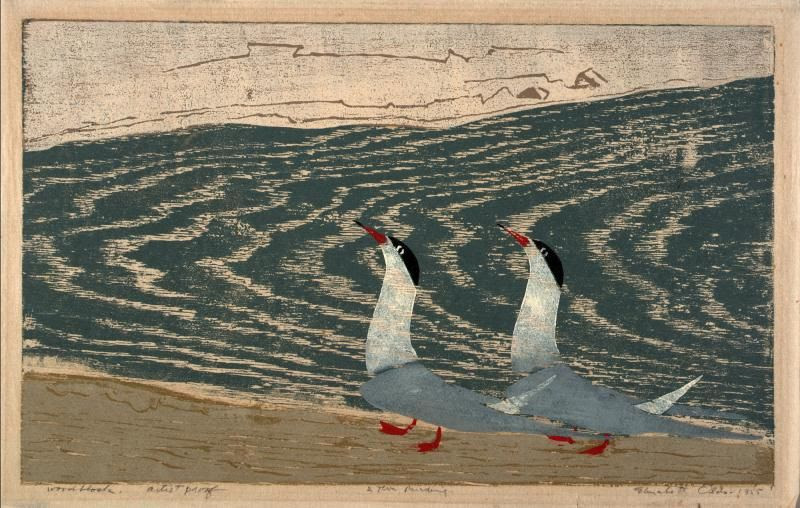Monday, July 5, 2021 – DISCOVERING ANOTHER ARTIST THAT WAS WORKING FOR THE WPA


MONDAY, JULY 5, 2021
THE
407th EDITION
FROM THE ARCHIVES
ELIZABETH OLDS
ARTIST

Elizabeth Olds, Dead End Beach, ca. 1940-1945, screenprint on paper, Smithsonian American Art Museum, Transfer from the Archives of American Art, Smithsonian Institution, 1984.31.43
Elizabeth Olds (December 10, 1896 – March 4, 1991) was an American artist known for her work in developing silkscreen as a fine arts medium. She was a painter and illustrator, but is primarily known as a printmaker, using silkscreen, woodcut, lithography processes. In 1926, she became the first female honored with the Guggenheim Fellowship. She studied under George Luks,[4] was a Social Realist, and worked for the Public Works of Art Project and Federal Art Project during the Great Depression. In her later career, Olds wrote and illustrated six children’s books.

Elizabeth Olds, The Middle Class, ca. 1939, lithograph on paper, Smithsonian American Art Museum, Transfer from the Archives of American Art, Smithsonian Institution, 1984.31.7
Early life and education
Olds was born in Minneapolis, Minnesota to a middle-class family.[4] Olds’s mother was an art historian, and her mother exposed Olds and her sister, Eleanor, to art through visits to the Walker Art Center and Minneapolis Institute of Arts.[Olds’s art was first documented in her high school yearbook, featuring a cartoon sketch of a goose at tea.[ She studied Home Economics and Architectural Drawing at the University of Minnesota from 1916-1918, and received a scholarship to study at the Minneapolis College of Art and Design from 1918-1921. In 1921, Olds received another scholarship to study at the Art Students League of New York where she studied under George Luks.
Career
Early works
The early style of Olds reflects Luks’s influence on her art. The pair experimented with the style and themes of the Ashcan school, visiting the Lower East Side of New York to observe the exotic urban immigrant. During the summers from 1923-1925, Olds was invited to the circles of The Roots and their friends and the Percy Saunders of Clinton, New York.[4] In 1925, with the help of Elihu Root and some bankers, Olds was funded to travel to France.[4] While in France, she observed and sketched the famous circus family, the Fratellini family, and their show, “Cirque d’Hiver.”Olds later joined the troupe as a trick bareback rider.In 1926, Olds became the first woman awarded with the Guggenheim Fellowship, and was granted further travel in Europe.

Elizabeth Olds, Harlem River Bridges, ca. 1935-1940, lithograph on paper, Smithsonian American Art Museum, Transfer from the Archives of American Art, Smithsonian Institution, 1984.31.37

Elizabeth Olds, Harlem River Bridges, 1940, screenprint on paper, Smithsonian American Art Museum, Transfer from the Archives of American Art, Smithsonian Institution, 1984.31.32
Great Depression
For those visiting the Hunters Point area of Queens this summer, MoMA’s PS1 outdoor courtyard will feature an experiment in creative ecologies. As a leading space within the neighborhood’s community, the new installation will reimagine the use and access of the PS1 courtyard. It will feature Rashid Johnson’s Stage, a participatory installation and sound work, which draws on the history of the microphone as a tool of protest and public oratory. It will feature a yellow powder-coated stage, with Johnson’s signature markings engraved onto it, and five SM58 microphones of varying heights. Stage’s design echoes that of other unofficial sites of public intellectual and cultural life like Harlem’s 135th Street and Lenox Avenue. Visitors will have the opportunity to speak to the public on the stage, with their words being recorded and broadcasted in the courtyard. In addition, the stage will feature a number of performances from artists, activists, poets, and musicians.
Two Boys, a painting by Elizabeth Olds for the United States Works Progress Administration
Olds was fairly sheltered from the Great Depression when she returned to the U.S. in 1929. In 1932, Olds viewed José Clemente Orozco’s nearly finished murals at Dartmouth College, and was inspired by his expressive use of form and political themes.The same year, she moved to Omaha, Nebraska to paint portraits of the family of Samuel Rees, a local industrialist.[6] Olds completed the project, but she became frustrated with the monotony of painting portraits. At the same time Olds was studying the basics of lithography at Rees’s printing business.
From 1933-1934, Olds was invited to join the Public Works of Art Project (PWAP) in Omaha. Under the PWAP, Olds created a series of lithographs featuring the bread lines, shelters, and clinics of the Great Depression.[ Olds’s break from portraiture was fruitful as she developed her style and content, which like Orozco’s murals, used broad, expressive lines and portrayed political themes. Later, Olds studied at a meat packing plant, which inspired her ‘’Stockyard Series’’. “Sheep Skinners,” one of the ten black-and-white lithographs, was exhibited in 1935 in the Weyhe Gallery in New York as one of the “Fifty Best Prints of the Year.”
From 1935 until the early 1940s, Olds was a nonrelief employee for the Works Progress Administration-Federal Art Project (WPA-FAP) in the Graphic Arts Division in New York,[9] where she helped younger artists in the silkscreen unit.[10] She also joined the American Artists’ Congress, Artists Union, and other groups with similar interests. Olds became friends with Harry Gottlieb, another nonrelief artist who also focused on industrialism.[7] Together, they observed the mining and steel industries of New York, and their research lead to Olds’s creation of her award-winning print, “Miner Joe.”[ Olds used both silkscreen and lithography for the prints for ‘‘Miner Joe,’’ but it was her lithograph that won first place for the Philadelphia Print Club competition in 1938.
Olds and Gottlieb experimented with silkscreen printing as a fine arts medium. They accomplished this with a few other artists in the silkscreen unit of the Graphic Arts Division of the WPA-FAP in New York. From 1939 until 1941, Olds and Gottlieb opened and ran the independent Silk Screen School for students interested in learning the newest printmaking technologies.Her work was included in the 1940 MoMA show American Color Prints Under $10. The show was organized as a vehicle for bringing affordable fine art prints to the general public.
Olds submitted and reproduced 10 prints in The New Masses in 1936 and 1937, a leftist magazine at the time. In the United American Artists under the Public Use of Art Committee, Olds and other artists worked to produce murals along New York City Subway walls, but the murals were never installed.] Olds’s art reflected her leftist political views, but also her social and political awareness at the time. As a WPA-FAP employee, Olds’s prints were intended to go to the government for their purposes, but she selectively sent her leftist prints to George C. Miller, an independent lithographer.

Elizabeth Olds, Me and Her, ca. 1940-1970, screenprint on paper, Smithsonian American Art Museum, Transfer from the Archives of American Art, Smithsonian Institution, 1984.31.31
Elizabeth Olds, Harlem Musicians, ca. 1937, screenprint on paper, Smithsonian American Art Museum, Transfer from the Archives of American ArElizabeth Olds,
Two Terns Parading, 1955, color woodcut on paper, Smithsonian American Art Museum, Transfer from the Archives of American Art, Smithsonian Institution, 1984.31.t, Smithsonian Institution, 1984.31.2

Elizabeth Olds, Burlesque, ca. 1935-1945, lithograph on paper, Smithsonian American Art Museum, Transfer from the Archives of American Art, Smithsonian Institution, 1984.31.40

Elizabeth Olds, Birds in a Hurry, 1954, color woodcut and screenprint on paper, Smithsonian American Art Museum, Transfer from the Archives of American Art, Smithsonian Institution, 1984.31.46
Later works
After the war, Olds redirected her skills and began experimenting with watercolor, collage, and woodblock prints] Her silk screen, “Three Alarm Fire” (1945), prompted Roberta Fansler to suggest that Olds should illustrate children’s books.] From 1945-1963, Olds wrote and illustrated six children’s books. In three of her books, Olds wrote about firefighters, trains, and oil, educating her readers about industrialism.
In the early 1950s, Olds was hired as an illustrator-reporter for The New Republic and Fortune (magazine).[18] In the summers of the 1950s and 1960s, Olds was awarded artist-in-residence positions at the artists’ colonies of Yaddo near Saratoga Springs in New York and McDowell in Peterborough, New Hampshire. Her papers are held at the University of Texas.
MONDAY PHOTO OF THE DAY
SEND YOUR RESPONSE TO:
ROOSEVELTISLANDHISTORY@GMAIL.COM

WEEKEND PHOTO
THE ORIGINAL WALDORF ASTORIA HOTEL AT
350 FIFTH AVENUE
ANDY SPARBERG AND LAURA HUSSEY GOT IT RIGHT

Text by Judith Berdy
Thanks to Bobbie Slonevsky for her dedication to Blackwell’s Almanac and the RIHS
Thanks to Deborah Dorff for maintaining our website
Edited by Deborah Dorff
All image are copyrighted (c)
SMITHSONIAN AMERICAN ART MUSEUM
WIKIPEDIA
FUNDING PROVIDED BY ROOSEVELT ISLAND OPERATING CORPORATION PUBLIC PURPOSE GRANTS CITY COUNCIL REPRESENTATIVE BEN KALLOS DISCRETIONARY FUNDING THRU DYCD


Copyright © 2021 Roosevelt Island Historical Society, All rights reserved.Our mailing address is:
rooseveltislandhistory@gmail.com



Leave a comment